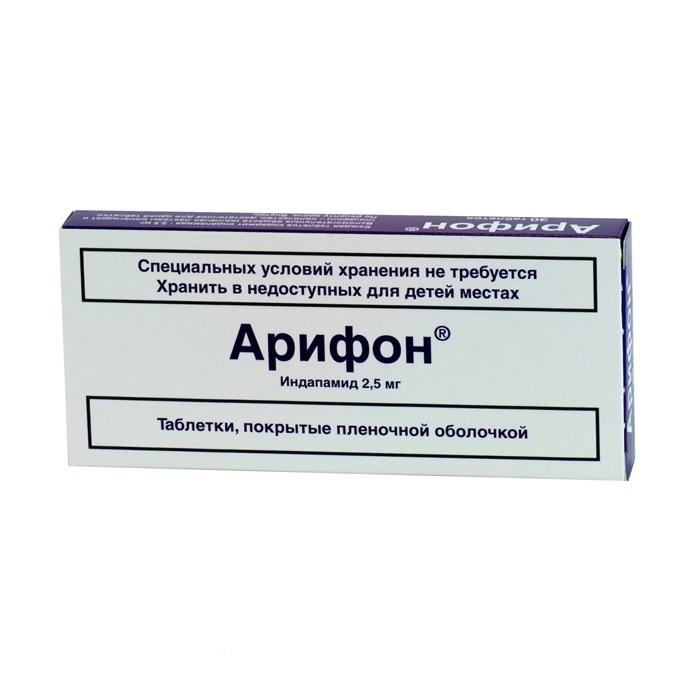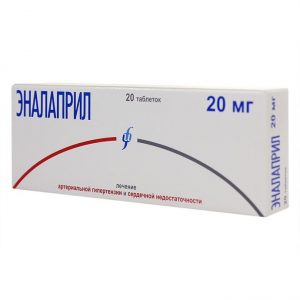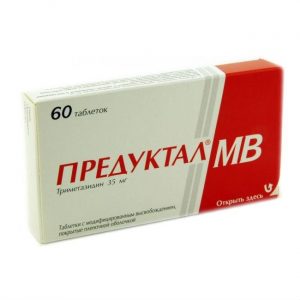Description
Packing
30 pcs
Pharmacological action
Arifon – An antihypertensive (diuretic) drug, a sulfonamide derivative containing an indole ring. By pharmacological properties, indapamide is close to thiazide diuretics, the effect of which is associated with inhibition of the reverse absorption of sodium ions in the cortical segment of the nephron loop. Indapamide increases urinary excretion of sodium, chlorine and, to a lesser extent, potassium and magnesium ions, which is accompanied by increased urine output. Indapamide has an antihypertensive effect in doses that do not have a pronounced diuretic effect. Moreover, hypotensive effect is associated with the ability of the drug to increase the elasticity of the walls of the arteries and reduce OPSS.
The mechanism of action of indapamide is due to a change in the transmembrane current of ions (primarily calcium), which leads to relaxation of vascular smooth muscle cells, as well as increased synthesis of prostaglandins PGE2 and prostacyclin PGI2 (a vasodilator and platelet aggregation inhibitor).
The drug helps to reduce left ventricular hypertrophy.
Clinical trials of Arifon showed that with monotherapy a persistent hypotensive effect develops, which persists for 24 hours, while a moderate increase in diuresis was observed.
Regardless of the duration of use, Arifon does not affect plasma lipids (triglycerides, cholesterol / LDL, cholesterol / HDL) does not change the parameters of carbohydrate metabolism (including in patients with arterial hypertension and diabetes mellitus).
Indapamide is effective in patients with one kidney.
Indapamide has an antihypertensive effect in doses that do not have a pronounced diuretic effect.
When using indapamide in high doses, the hypotensive effect is not enhanced, but diuresis is increased.
Indications
Essential arterial hypertension
Contraindications
severe renal failure
hepatic encephalopathy
hypokalemia
hypersensitivity to sulfonamide derivatives.
Concurrent use of Arifon and drugs should be avoided lengthening the QT interval
Use during pregnancy and lactation
As a rule, Arifon is not recommended for use during pregnancy, including to relieve physiological edema. It should be borne in mind that diuretics can cause fetoplacental ischemia and lead to impaired fetal development.
Due to the fact that indapamide is excreted in breast milk, it is also not recommended to prescribe the drug during breastfeeding. If therapy is necessary, breast-feeding should be discontinued.
Composition
1 tablet contains:
Active ingredient: indapamide 2.5 mg
Excipients: lactose monohydrate – 59.25 mg corn starch – 20.00 mg magnesium stearate – 0.75 mg povidone – 4, 00 mg talcum powder – 3.5 mg
Film coating: glycerol – 0.087 mg macrogol 6000 – 0.035 mg magnesium stearate – 0.087 mg hypromellose – 1.499 mg sodium lauryl sulfate – 0.017 mg titanium dioxide – 0.278 mg white beeswax – 0.047 mg.
Dosage and administration
Inside, preferably in the morning, 1 tablet per day.
In the treatment of patients with arterial hypertension, the dose of the drug should not exceed 2, 5 mg / day (increased risk of side effects without increased antihypertensive effect).
Drug interaction
With the simultaneous use of thiazide diuretics and lithium preparations, an increase in the concentration of lithium in the blood plasma is possible, accompanied by the appearance of signs of overdose (due to a decrease in the excretion of lithium in the urine). If necessary, the appointment of this combination should monitor the concentration of lithium in blood plasma.
With the simultaneous use of diuretics with astemizole, bepridil, erythromycin (iv), halofantrine, pentamidine, sultopride, terfenadine, vincamine, the likelihood of pirouette arrhythmia increases. Hypokalemia, bradycardia, or an extended QT interval may contribute to this condition.
With simultaneous use with NSAIDs (for systemic use), high doses of salicylates, a decrease in the hypotensive effect of indapamide is possible. With significant fluid loss, acute renal failure may develop (due to a sharp decrease in glomerular filtration). If necessary, the appointment of NSAIDs during therapy with Arifon, water loss should be compensated for and kidney function should be carefully monitored.
With the simultaneous use of indapamide with other drugs that can cause hypokalemia, including with amphotericin B (iv), gluco- and mineralocorticoids (for systemic use), tetracosactide, laxatives that stimulate intestinal motility, the risk of hypokalemia increases (constant monitoring of the level of potassium in the blood plasma is required and, if necessary, appropriate treatment) .
With the simultaneous use of thiazide diuretics with GCS, tetracosactide for systemic use, a decrease in the hypotensive effect is observed due to the retention of water and sodium ions under the influence of GCS.
With simultaneous use with cardiac glycosides, the toxic effects of the latter may be increased (it is necessary to control the level of potassium in the blood plasma and ECG values).
With the simultaneous use of indapamide with baclofen, an increase in the hypotensive effect is noted (it is necessary to compensate for the loss of water and carefully monitor renal function at the beginning of treatment).
With the simultaneous use of indapamide and potassium-sparing diuretics (including amiloride, spironolactone, triamteren), the possibility of developing hypokalemia or hyperkalemia cannot be completely excluded, especially in patients with diabetes mellitus and renal failure. In such cases, you should monitor the level of potassium in the blood plasma, ECG parameters and, if necessary, adjust the therapy.
With the simultaneous use of indapamide with ACE inhibitors, hyponatremia in patients receiving ACE inhibitors increases the risk of sudden arterial hypotension and / or acute renal failure (especially with renal artery stenosis). Patients with essential arterial hypertension and a decrease in the content of sodium ions in the blood plasma due to the intake of diuretics should stop taking diuretics 3 days before the start of treatment with ACE inhibitors. In the future, if necessary, resume the intake of diuretics. In addition, low, gradually increasing doses of ACE inhibitors are prescribed. In chronic heart failure, treatment should begin with low doses of ACE inhibitors, previously reducing the dose of diuretics. In all cases, in the first week of taking ACE inhibitors, it is necessary to monitor renal function (creatinine in plasma).
With the simultaneous administration of indapamide and antiarrhythmic drugs that can cause arrhythmias such as pirouette (including quinidine, hydroquinidine, disopyramide, amiodarone, bretilium, sotalol), the risk of developing this condition increases (especially against hypokalemia, bradycardia, an initially extended QT interval ) If necessary, the appointment of this combination should monitor the level of potassium in the blood plasma and the QT interval, adjusting the dosage regimen.
With the simultaneous use of diuretics and metformin, lactic acidosis may occur, which is associated with apparently, with the development of functional renal failure due to the action of diuretics (mostly loopback). It is not recommended to use metformin in combination with Arifon at a creatinine level of more than 15 mg / L (135 μmol / L) in men and 12 mg / L (110 μmol / L) in women.
When using iodine-containing radiopaque drugs, it should be borne in mind that the diuretic effect of indapamide increases the risk of developing renal failure. This risk is especially high when using iodine-containing radiopaque substances in high doses. Before using iodine-containing radiopaque substances, patients need to restore fluid loss.
With the simultaneous use of indapamide and tricyclic antidepressants such as imipramine, an increase in the hypotensive effect and an increased risk of orthostatic hypotension are observed.
With the simultaneous use of thiazide diuretics and calcium salts, the development of hypercalcemia is possible due to a decrease in the excretion of calcium ions in the urine.
With the simultaneous use of indapamide and cyclosporine, an increase in plasma creatinine is possible, which is observed even with a normal content of water and sodium ions.
Overdose
Symptoms: water-electrolyte balance disorders (hyponatremia, hypokalemia), nausea, vomiting, arterial hypotension, convulsions, dizziness, drowsiness, confusion, polyuria,
Treatment: Immediate measures to eliminate the drug from the body: flushing of the gastrointestinal tract and / or the appointment of activated carbon followed by the restoration of normal water-electrolyte balance.
Storage conditions
The product should be stored in a dry place at a temperature not exceeding 30 ° C.
Deystvuyushtee substance
Indapamide
dosage form
tablets
Servye, France




